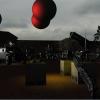I was told Minecraft was made by 1 person
Minecraft STARTED OUT being made by one person. Then Notch hooked up with some friends to add people, started working with Mojang, got lots of money from early alpha builds.
By the time 1.0 was released in 2011 came around and it was released for real, the credits file was at 16 people. Four years * probably 10 people at average = 40 work years.
At a guess, today the game probably has around 500 to 800 work years behind it for the PC version, plus several hundred more considering all the ports.
It started as a single person, but the game you know today would be impossible for a single person, even if they dedicated their entire lifetime to it alone.
Can these engines be used to make games like...
Yes, in a general sense.
The games you listed have large development teams, anywhere from double-digit to triple-digit numbers of people. And many have multi-year timeframes. Big games have total development times that are not measured in work-years, but in work-centuries.
As an individual you will not be creating a game like Ultima Online or Assassins Creed 4. You do not have the time in your lifetime to create all those assets, all the models, all the animations, all the code, all the audio, all the effects, maintain all the computer networks, and all the rest.
You can leverage the tools to create games quickly. You can get the pieces you don't have by working with collaborators or by buying/licensing them, and there are many resources available at very low cost or even free.
So with the caveat that you only have a small number of work-hours you can invest in the project --- rather than work-centuries --- you can build a game with similar elements using the tools.
Just be sure to scale your work appropriately. Something you spend several months on -- perhaps 60 work hours -- will be at a radically different scale than a major game developed with 200,000 work hours (100 work years).
Where can I find or learn how to make such algorithms?
The typical source is a college degree in Computer Science.
Some people take a different route of self education, but that is more difficult. A school will require you to study topics you would not study on your own, will require a minimum depth on topics that you don't like and would not study on your own. If you want to work professionally, you are not in a vacuum and these days most of your peers will have college degrees, so if you don't your application is far less likely to get through the HR filters (unless you have published games in your history, but then you've got a chicken-and-egg problem).
There is much to learn. After 4 years of schooling focused in Computer Science, the first job is still entry level. That is to say, four years of study is enough to qualify you as a beginner. It is not until another five to ten years of full-time experience that individuals are considered to have mastered the craft.
And all those years are only the code. Not modeling, not animation, not design. These crafts take similar years to master.
If a computer science college program is not available right now, start by learning whatever you can, wherever you can. Books aimed for first-year and second-year college students are a good start, since online tutorials are hit and miss. Search the forums for frequent book recommendations on specific topics. There are book lists for learning C++, learning C#, and learning other things.
... to know if there are any game engines, such as Unity, UE4 or CryEngine, that support such animations. Should I choose C++, C# or some other language for this project...
Download Unity and UE4 and try them out. One is focused on C#, the other C++. Blender is one of the best free 3D modeling and animation packages out there, so pull it down as well. For image editing, GIMP is the best free program.
Try them out, experiment with them, and learn as you go.











